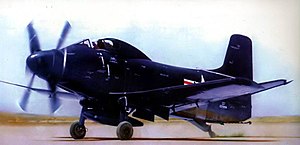Douglas A2D
| Douglas A2D Skyshark | |
|---|---|
 XA2D-1 Skyshark prototype |
|
| Type: | Fighter bomber |
| Design country: | |
| Manufacturer: | |
| First flight: |
May 26, 1950 |
| Production time: |
1950 to 1953 |
| Number of pieces: |
12 |
The Douglas A2D Skyshark was a fighter-bomber of the US company Douglas Aircraft Company , which was developed for the United States Navy from 1945 to 1952 , but was never put into service after problems with the engine.
development
The US Navy's Bureau of Aeronautics (BuAer) commissioned Douglas on June 25, 1945 to develop a fighter-bomber with turboprop propulsion. Douglas named the project D-557 and developed three designs over the next year and a half. The D-557A was to receive a General Electric TG-100 turboprop engine in each of the nacelles in the wings, the D-557B was to receive the TG-100 with counter-rotating propellers and the D-557C was to be equipped with the Westinghouse 25D. 1: 1 dummies were built ; However, plans to equip an AD Skyraider with a turboprop engine were refrained from as they were not yet operational.
Douglas received a preliminary order on June 11, 1947. The aircraft should now have a range of 1000 km and be able to operate from small escort carriers . Douglas then developed an aircraft with the Allison XT40 that was vaguely reminiscent of the Skyraider.
The aircraft called the XA2D-1 Skyshark was to have an AN / APS-19 radar in the propeller hood and be able to carry 2500 kg at 11 external load stations under the wings and fuselage. The first prototype first flew on May 26, 1950 on Rogers Dry Lake . After the outbreak of the Korean War , the US Navy ordered 10 prototypes and 81 production aircraft. Douglas prepared series production.
However, strong engine vibrations occurred in the prototype and the aircraft crashed on December 19, 1950, whereby the test pilot, Lt. Cmdr. Hugh Wood Jr. was killed. The next A2D did not fly until April 3, 1952, but the problems with the engine remained. As early as mid-1952, consideration was given to discontinuing the program, and at the end of 1952 the US Navy canceled the order for the 81 series aircraft. Douglas was to produce the successful Skyraider and funds for the A2D were diverted to the jet-powered A4D Skyhawk fighter-bomber . The A2D suffered the same fate as all other aircraft that were equipped with the XT-40, e.g. B. the North American XA2J Super Savage and the Convair R3Y Tradewind .
A total of 12 A2Ds were built, but only eight of them flew. Bureau No. (BuNo) 125485 has been preserved and is on display at Idaho Falls Regional Airport , Idaho (USA) .
Versions
- XA2D-1
- two prototypes (BuNo 122988/122989).
- A2D-1
- 10 series aircraft (BuNo 125479 to 125488), of which four (125485–125488) never flew due to engine problems. The order for 81 more (127962–128042, 132793–133042, 134438–134445) was canceled.
Technical specifications
| Parameter | A2D-1 data |
|---|---|
| crew | 1 |
| length | 12.58 m |
| span | 15.24 m |
| height | 5.20 m |
| Wing area | 37.16 m² |
| Wing extension | 6.3 |
| Empty mass | 5,864 kg |
| Max. Takeoff mass | 8,500 kg |
| Wing loading | 320 kg / m² |
| Top speed | 813 km / h |
| Service ceiling | 14,664 m |
| Range (max.) | 3,520 km |
| drive | an Allison XT40-A-2 turboprop engine with 5,100 WPS (3,800 kW) |
Armament
- four 20 mm guns
- up to 2,500 kg external loads at 11 external load stations :
See also
literature
- Francillon, René J .: McDonnell Douglas Aircraft since 1920 . London 1979. ISBN 0-370-00050-1 .
- Heinemann, Edward H. and Rausa, Rosario: Combat Aircraft Designer . London 1980. ISBN 0-7106-0040-2 .
- Margrave, Gerry: Douglas Skyshark, A2D Turbo-Prop Attack (Naval Fighters No. 43). Simi Valley (USA) 1997. ISBN 0-942612-43-4 .
Web links
- A2D Skyshark by Joe Baugher (in English)
Individual evidence
- ^ Francillion, p. 472.
- ↑ Heinemann / Rausa 1980, p. 177.
- ↑ a b c Douglas XA2D-1 Skyshark. Retrieved June 16, 2020 (English).
- ↑ Heinemann / Rausa, p. 183.
- ^ Douglas A2D Skyshark - carrier-borne attacker. Retrieved June 16, 2020 (English).


